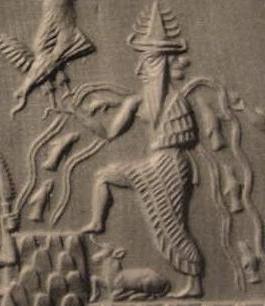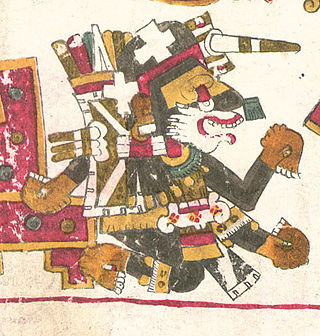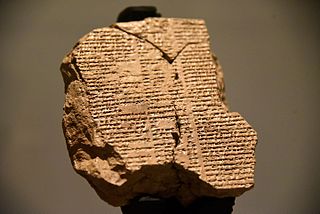
In Norse mythology, Ask and Embla —male and female respectively—were the first two humans, created by the gods. The pair are attested in both the Poetic Edda, compiled in the 13th century from earlier traditional sources, and the Prose Edda, written in the 13th century by Snorri Sturluson. In both sources, three gods, one of whom is Odin, find Ask and Embla and bestow upon them various corporeal and spiritual gifts. A number of theories have been proposed to explain the two figures, and there are occasional references to them in popular culture.

Enki is the Sumerian god of water, knowledge (gestú), crafts (gašam), and creation (nudimmud), and one of the Anunnaki. He was later known as Ea or Ae in Akkadian (Assyrian-Babylonian) religion, and is identified by some scholars with Ia in Canaanite religion. The name was rendered Aos in Greek sources.

Ninḫursaĝ sometimes transcribed Ninursag, Ninḫarsag, or Ninḫursaĝa, also known as Damgalnuna or Ninmah, was the ancient Sumerian mother goddess of the mountains, and one of the seven great deities of Sumer. She is known earliest as a nurturing or fertility goddess. Temple hymn sources identify her as the "true and great lady of heaven" and kings of Lagash were "nourished by Ninhursag's milk". She is the tutelary deity to several Sumerian leaders.

In Aztec mythology, the god Nanahuatzin or Nanahuatl, the most humble of the gods, sacrificed himself in fire so that he would continue to shine on Earth as the Sun, thus becoming the sun god. Nanahuatzin means "full of sores." According to a translation of the Histoyre du Mechique, Nanahuatzin is the son of Itzpapalotl and Cuzcamiahu or Tonan, but was adopted by Piltzintecuhtli and Xōchiquetzal. In the Codex Borgia, Nanahuatzin is represented as a man emerging from a fire. This was originally interpreted as an illustration of cannibalism. He is probably an aspect of Xolotl.
The Tupi-Guarani mythology is the set of narratives about the gods and spirits of the different Tupi-Guarani peoples, ancient and current. Together with the cosmogonies, anthropogonies and rituals, they form part of the religion of these peoples.
In Hawaiian mythology, Kāne is considered the highest of the three major Hawaiian deities, along with Kū and Lono. He represented the god of procreation and was worshipped as ancestor of chiefs and commoners. Kāne is the creator and gives life associated with dawn, sun and sky. No human sacrifice or laborious ritual was needed in the worship of Kāne. In the Kumuhonua legend, he created Earth, bestowed upon it sea creatures, animals, plants, as well as created man and woman.

In Mesopotamian religion, Tiamat is a primordial goddess of the sea, mating with Abzû, the god of the groundwater, to produce younger gods. She is the symbol of the chaos of primordial creation. She is referred to as a woman and described as "the glistening one". It is suggested that there are two parts to the Tiamat mythos. In the first, she is a creator goddess, through a sacred marriage between different waters, peacefully creating the cosmos through successive generations. In the second Chaoskampf Tiamat is considered the monstrous embodiment of primordial chaos. Some sources identify her with images of a sea serpent or dragon.

The Enūma Eliš is the Babylonian creation myth. It was recovered by English archaeologist Austen Henry Layard in 1849 in the ruined Library of Ashurbanipal at Nineveh. A form of the myth was first published by English Assyriologist George Smith in 1876; active research and further excavations led to near completion of the texts and improved translation.

Atra-Hasis is an 18th-century BCE Akkadian epic, recorded in various versions on clay tablets, named for its protagonist, Atrahasis. The Atra-Hasis tablets include both a creation myth and one of three surviving Babylonian flood myths. The name "Atra-Hasis" also appears, as king of Shuruppak in the times before a flood, on one of the Sumerian King Lists.
Zababa was the tutelary deity of the city of Kish in ancient Mesopotamia. He was a war god. While he was regarded as similar to Ninurta and Nergal, he was never fully conflated with them. His worship is attested from between the Early Dynastic to Achaemenid periods, with the Old Babylonian kings being particularly devoted to him. Starting with the Old Babylonian period, he was regarded as married to the goddess Bau.

Adam is the name given in Genesis 1-5 to the first human. Beyond its use as the name of the first man, adam is also used in the Bible as a pronoun, individually as "a human" and in a collective sense as "mankind". Genesis 1 tells of God's creation of the world and its creatures, including adam, meaning humankind; in Genesis 2 God forms "Adam", this time meaning a single male human, out of "the dust of the ground", places him in the Garden of Eden, and forms a woman, Eve, as his helpmate; in Genesis 3 Adam and Eve eat the fruit of the tree of knowledge and God condemns Adam to labour on the earth for his food and to return to it on his death; Genesis 4 deals with the birth of Adam's sons, and Genesis 5 lists his descendants from Seth to Noah.
Belet-Seri was a Mesopotamian goddess who served as a scribe in the court of the underworld goddess Ereshkigal. She could be regarded as the Akkadian counterpart of Sumerian Geshtinanna, but the name could also function as a title of Ašratum, the wife of Amurru, or as a fully independent deity.
Ilawela is, in Sumerian and Akkadian mythology, a minor god of intelligence. In the Atra-Hasis Epic he was sacrificed by the great gods and his blood was used in the creation of mankind:
Ilawela who had intelligence,
They slaughtered in their assembly.
Nintu mixed clay
With his flesh and blood.
They heard the drumbeat forever after.
A ghost came into existence from the god’s flesh,
And she (Nintu) proclaimed it as his living sign.
The ghost existed so as not to forget. […]
You have slaughtered a god together with his intelligence.
I have relieved you of your hard work.
I have imposed your load on man.
Ninegal or Belat Ekalli (Belet-ekalli) was a Mesopotamian goddess associated with palaces. Both her Sumerian and Akkadian name mean "lady of the palace."
Alalu or Alala was a primordial figure in Mesopotamian and Hurrian mythology. He is also known from documents from Emar. While his role was not identical in these three contexts, it is agreed that all three versions share the same origin.

The creation of life from clay is a miraculous birth theme that appears throughout world religions and mythologies.
The Cuthean Legend of Naram-Sin is one of the few literary works whose versions are attested in both Old Babylonian, Middle Babylonian and the Standard Babylonian of the late Neo-Babylonian period, a literary life of around 1,500 years. It seems to have earlier been titled ṭupšenna pitēma, or "Open the Tablet Box" after its incipit and was re-titled Naram-Sin and the Enemy Hordes, after its subject matter by its last Babylonian editor.

Mesopotamian mythology refers to the myths, religious texts, and other literature that comes from the region of ancient Mesopotamia which is a historical region of Western Asia, situated within the Tigris–Euphrates river system that occupies the area of present-day Iraq. In particular the societies of Sumer, Akkad, and Assyria, all of which existed shortly after 3000 BCE and were mostly gone by 400 CE. These works were primarily preserved on stone or clay tablets and were written in cuneiform by scribes. Several lengthy pieces have survived, some of which are considered the oldest stories in the world, and have given historians insight into Mesopotamian ideology and cosmology.
Kanisurra was a Mesopotamian goddess who belonged to the entourage of Nanaya. Much about her character remains poorly understood, though it is known she was associated with love. Her name might be derived from the word ganzer, referring to the underworld or to its entrance. In addition to Nanaya, she could be associated with deities such as Gazbaba, Ishara and Uṣur-amāssu. She is first attested in sources from Uruk from the Ur III period, and continued to be worshiped in this city as late as in the Seleucid period.
Iqbi-damiq was a Mesopotamian goddess who was regarded as one of the "Daughters of Edubba", and was worshiped in Kish for this role. According to the god list An = Anum she also functioned as the sukkal of Niĝgina. She is mentioned in texts of Assur and Babylon. An illness named after her, the "hand of Iqbi-damiq," is known from texts focused on medicine and omens.








